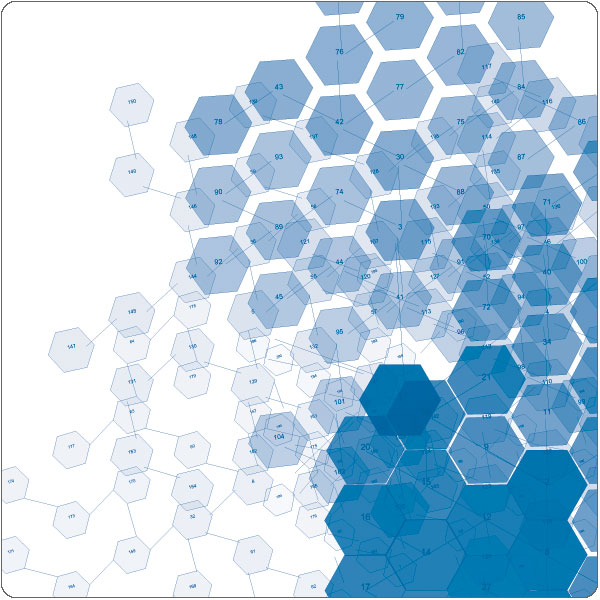Glacier
Glacier draws a grid of interconnecting hexagonal elements with a recursive algorithm. The grid fades out after a certain amount of tiles. The algorithm contains a bug in the way hexes are spaced, but this actually creates a nice visual effect: the glaciers start drifting apart the further they are from the core. A global warming bug!

Source code:
size(600, 600) hexwork = {} class Hex: def __init__(self, x, y, w, spacing=0): #Creates a new hexagonal at position x, y #with the given width w, and optional spacing. #Adds itself to the hexwork list. self.x = x self.y = y self.w = w self.spacing = spacing self.sides = [] for i in range(6): self.sides.append(None) global hexwork hexwork[(self.x,self.y)] = self self.index = len(hexwork) def draw(self, tag=False, visit=None): #Draws this hexagonal on screen. #Optionally, tags the hexagonal with its index #in the hexwork list. #Additionally, you can supply a visit function #that accepts this self as a parameter. if visit != None: visit(self) w = self.w * 0.5 star(self.x, self.y, 6, w, w*1.155) if tag: fontsize(w*0.25) f = fill() fill(f.r, f.g, f.b, 1) align(CENTER) text(str(self.index), self.x-self.w*0.5, self.y, self.w) fill(f) def rdraw(self, tag=False, visit=None, degrade=True, root=None): #Recursive draw: #draw all neighbours as well, #and their neighbours, and so on. if degrade == True: f = fill() fill(f.r, f.g, f.b, f.a * 0.98) self.draw(tag, visit) if root != None: line(self.x,self.y,root.x,root.y) for side in self.sides: if side != None and side != root: side.rdraw(tag, visit, degrade, root=self) def grow(self, max=6): #Creates neighbouring hexes for this hexagonal. #Creates all neighbours by default, or a given max #of random neighbours. if max < 1 or max > 6: return #The centerpoint offsets for neighbouring hexes. from random import shuffle center = [(0,-1), (-0.865,-0.5), (-0.865,0.5), (0,1), (0.865,0.5), (0.865,-0.5)] shuffle(center) center = center[:max] #center.sort() #doesn't do what supposed to do #Create neighbours only if the neighbour does #not exist yet: if it is not defined by this #hex as a neighbour already, or its position #occurs in the hexwork list (and thus it is #already defined as someone else's neighbour). for i in range(max): dx, dy = center[i] dx = dx * (self.w+self.spacing) + self.x dy = dy * (self.w+self.spacing) + self.y global hexwork if self.sides[i] == None and not hexwork.has_key((dx,dy)): self.sides[i] = Hex(dx, dy, self.w) self.sides[i].sides[(i+3)%6] = self def rgrow(self, max=6): #Recursive growth: #grow neighbours for this hex, #grow neighbours for each neighbour, and so on. if max > 0: self.grow(max) for side in self.sides: if side != None: side.rgrow(max-1) def visit(hex): scale(random(0.98,1.01)) rotate(0.1) root = Hex(400,400,70, spacing=100) root.rgrow() nofill() stroke(0.2,0.2,0.2) strokewidth(0.5) rect(0,0,WIDTH,HEIGHT) font("Arial") r = random(0.5,1) fill(0,0.5,r,0.75) stroke(0,0.5,r,0.75) strokewidth(0.25) root.rdraw(tag=True, visit=visit)


